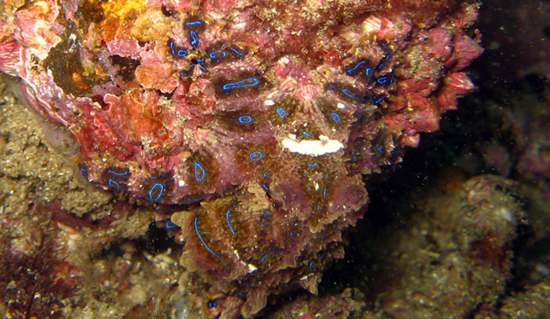
It's a pleasure to swim in clear, warm tropical waters and to take in all the colour and life along reefs and coastlines. But these areas can be just as dangerous as swimming in the wide open ocean. Most people think sharks are the only thing to worry about in the ocean. In fact, they may be the least of your concerns in certain parts of the world's oceans. The dangers along reefs and coastlines can be beautiful, surprising and potentially deadly.
1. Blue ringed octopus
Though tiny, this octopus species is considered one of the deadliest marine animals on earth.
This small, beautiful octopus can be found in tide pools and coral reefs in the Pacific and Indian oceans. It is also one of the most deadly marine animals in the world. If sharks are what you're mostly wary of when snorkelling, you may want to shift your priorities. The blue-ringed octopus, which grows to only about 5 to 8 inches, is armed with a venom powerful enough to kill a human, and there is no anti-venom for it.
According to Dr. James B. Wood, "The bite is slight and produces at most only a small laceration with no more than a tiny drop of blood and little or no discoloration. Bites are usually reported as being painless. Often the victim doesn't even know that he had been bitten. This can make it difficult for emergency and medical personnel to determine the cause of a patient's distress."
The venom causes paralysis and respiratory arrest within minutes, and victims can suffer from nausea, blindness, paralysis and cardiac arrest. Death, usually from lack of oxygen to the brain, can occur if a victim is not treated within a few minutes after the bite, which includes going on artificial breathing machines and other life-support machines until the toxin clears the system.
Thankfully, the octopus is usually docile and would rather swim away when feeling threatened. But it will bite if provoked. So if swimming in areas that are home to the blue-ringed octopus, know how to identify it and if you come across one, it is best to just let it be.
2. Box jellyfish
Box jellyfish are one marine animal you do not want to find yourself swimming among. They are famous for the level of pain their stings inflict, thanks to their strong venom. While the blue-ringed octopus is considered one of the most deadly marine animals, it is the Australian box jellyfish that is considered the most venomous. Only a handful of the 50 or so species of box jellyfish are to be feared, though.
According to the National Oceanic and Atmospheric Administration (NOAA), "While box jellyfish are found in warm coastal waters around the world, the lethal varieties are found primarily in the Indo-Pacific region and northern Australia... [The Australian box jellyfish] is the largest of the box jellyfish, with body sizes reaching up to one foot in diameter and thick, bootlace-like tentacles up to 10 feet long."
The lethal varieties of box jellyfish have tentacles covered in what are essentially miniscule poison darts. Coming into contact with the tentacles means being injected with venom from potentially thousands of these tiny stinging cells.
Though you may want to enjoy swimming in warm coastal waters while on vacation, pay attention to warning signs about the presence of box jellyfish in the area before diving in!
3. Irukandji jellyfish
They're almost impossible to see in the ocean, which adds insult to injury when stung.
This may be one of the smallest species of jelly in the world, but it's not one to trifle with! The powerful venom causes symptoms of severe muscle cramps, back and kidney pain, profuse sweating, nausea and vomiting, headaches and even psychological feelings like that of impending doom, symptoms that are collectively known as Irukandji syndrome. The syndrome is caused by even small doses of the venom.
Irukandji jellyfish are found around Australia, and have also been found in waters around Japan, Florida, the British Isles and Malaysia. They are tiny, with a bell measuring between only around a quarter of an inch to an inch across and four tentacles that can be anywhere from an inch or so to over three feet in length. Whereas most species of jelly only have stinging cells on the tentacles, this species also has them on its bell.
The sting itself is only mildly irritating but the syndrome may come on anywhere from five minutes to two hours after the sting and can last from a few hours to weeks. Victims of the stings usually require hospitalization and some serious painkillers. While the sting is a terrible thing to go through, it is normally not fatal - though at least two people have died from Irukandji syndrome in Australia.
4. Lionfish
They may be popular for aquariums but they're a real pain out in the ocean.
Lionfish may be a favourite for aquariums but they're a tough top predator along reefs. They eat practically anything to satisfy their voracious appetite, and have hardly any predators themselves thanks to their frilly defense mechanism.
Lionfish have as many as 18 dorsal fins that hold venomous spikes. The sting from a lionfish is extremely painful and can cause nausea, breathing difficulties, convulsions, sweating and other problems. Being stung is rarely fatal, but can cause heart failure in some victims.
Lionfish are one of the few fish species that have established new populations in open water after being introduced to an area. They are native to the Indo-Pacific but have been introduced to, and have become a serious invasive species, in the Atlantic and Caribbean.
5. Moray eel
These eels have a powerful bite and can take off a human's finger if prodded.
One of the lionfish's few predators is the moray eel. There are around 200 species of moray eel, and though many of the species such as the giant moray look menacing, none of them are inherently dangerous to humans.
The danger comes when humans provoke them and particularly when they try to feed them. Feeding moray eels is, unfortunately, common among dive tours as a way to thrill clients. However, many divers have lost fingers. In trying to hand feed, they've fed part of their hands to these fish with powerful jaws and sharp teeth.
The best way to stay safe around moray eels is to look, don't touch, and avoid disturbing them in their burrows. Luckily, the only way you could actually be killed by a moray eel is not if it eats you, but if you eat it. The eels accumulate ciguatoxin through eating toxic algae or fish that have eaten the algae, and can potentially poison humans who consume them.
6. Indonesian needlefish
These fish swimming at the surface of the water can be surprisingly dangerous.
Needlefish are not dangerous because they are aggressive, or are venomous or poisonous, or pack a mean bite. They're dangerous mostly only because of their shape if you happen to be in their way.
The dagger-shaped fish usually swim just a few inches below the water's surface, by they can launch themselves out of the water at speeds up to 37 miles per hour. The long, sharp jaws turn the fish into flying spears that can be up to three feet in length. When this happens, and a person is in the way, some rather horror-movie-esque results have occurred.
In 1997, a 10-year-old boy was killed while night fishing after a needlefish jumped from the water and pierced his eye and brain. Ten years later, a 16-year-old boy was killed while night diving when a needlefish stabbed him through the heart. In 2013, a man was killed when a needlefish pierced him in the neck. Other incidents include a needlefish stabbing a man in the foot in 2012, and a woman nearly killed in 2014 when a needlefish stabbed her in the neck.
In other words, they may not seem dangerous, but injuries and fatalities have occurred when these fish decide to turn up the speed without watching where they're going.
7. Sea snakes
Like moray eels, sea snakes aren't necessarily dangerous because they'd prefer not to waste their venom on humans. However, most species of sea snake have extremely powerful venom - some species even more powerful than cobras and among the most powerful of all snakes.
Living mostly in estuaries and lagoons close to shore, sea snakes are often caught by fishermen, and can inflict fatal bites. The most deadly of the sea snakes are two species that live in the waters off of Asia and Australia. Once thought to be the same species, it turns out they are two different species that look very similar, and both pack a lethal punch.
Though it isn't likely to be envenomated by typically shy and non-aggressive sea snakes, if a person is bitten, the bite itself is usually painless and not even noticed. However, from 30 minutes to a few hours after the bite, symptoms set in that include headache, thirst, vomiting, muscle aches, and later paralysis, renal failure and cardiac arrest.
Sea snakes, like sharks and many other "dangerous" animals, are actually more threatened by humans than the other way around. Harvesting sea snakes has become a booming trade and sea snakes are in serious danger of being over-harvested.
8. Stonefish
Their amazing ability to disguise themselves is part of what makes the stone fish such a devious danger.
Stonefish may come as a surprise in this list. They look like an innocuous rock, but actually that's what can make them so deadly. This is actually one of, if not the most venomous fish in the world. And because they look just like a stone, swimmers can find themselves is uncomfortably close proximity to one without even realizing it.
The stonefish species have neurotoxins in spines running along their dorsal fin, which stand up when the fish feels threatened. It is entirely a defensive mechanism, and releases venom only when pressure is applied to the spines. The amount of venom injected is usually dependent on the amount of pressure placed on the fish.
The venom causes extreme pain, swelling, temporary paralysis, shock and it could be fatal if not immediately treated with anti-venom.
Most incidents of being stung by stonefish occur from someone accidently standing on or grabbing a stonefish without realizing it. Thus, the easiest way to avoid being envenomated by a stonefish is not to stand on or around corals and rocks near reefs - something swimmers shouldn't do anyway because it risks harming corals. So if you won't avoid touching corals for the corals' sake, do it to avoid the possibility of extreme pain and potential death.
9. Cone snails
These beautiful snails have shells popular for decorations and jewellery. However when alive, you don't want to go picking one up. There are more than 800 species of cone snail and not all of them have powerful venom. But some species, especially the larger fish-eating snails, have venoms that are extremely toxic and potentially deadly.
Cone snails use an elongated barbed tooth to act as a harpoon, and it is used to inject venom that paralyzes prey before they eat it. For humans, many species have stings that feel a bit like a bee sting, but for species like the geography cone, striated cone and the textile cone or "cloth of gold cone" all have powerful venoms. When stung, symptoms include localized pain, swelling, vomiting and in extreme cases paralysis and respiratory failure. The effects can start immediately or be delayed even for days after the sting.
Deaths from cone snails are rare, with only around 15 humans deaths that point back to stings from these animals. But even so, don't handle them without caution.
On the up side, the powerful venom has potential for medical uses. The magician cone's venom shows promise as a pain reliever 100 times more powerful than morphine. IFLScience reports, "Although they have yet to be tried on humans, these modified peptides (small proteins) appear to dramatically reduce pain response in rats, even when given in very small doses. Craik estimates the effect is 100 times as large as morphine or gabapentin, the benchmark pain relief drugs. Since the cone-based drugs target different receptors to opiates it is thought unlikely they would produce the same addiction response." Meanwhile, the Queen Victoria cone's venom could possibly help speed up recovery from nerve injuries. Other possible drugs being explored include treatments for Alzheimer's and Parkinson's diseases, and possibly even depression.
Related on Mother Nature Network:
Top image: Blue-ringed octopus. Credit: David Breneman/Wikimedia Commons.
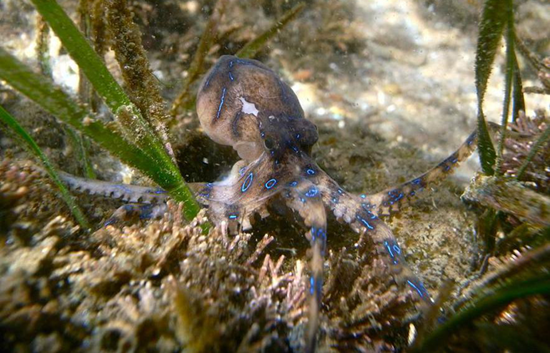




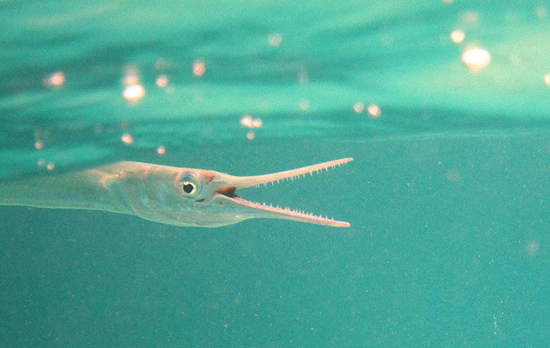
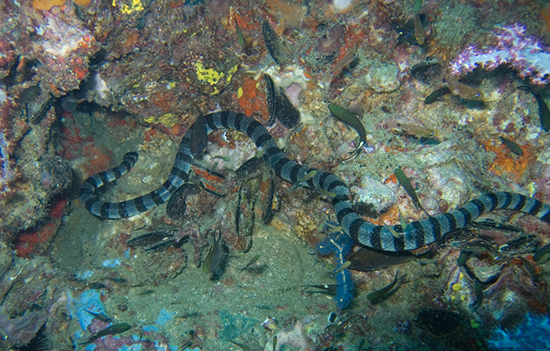
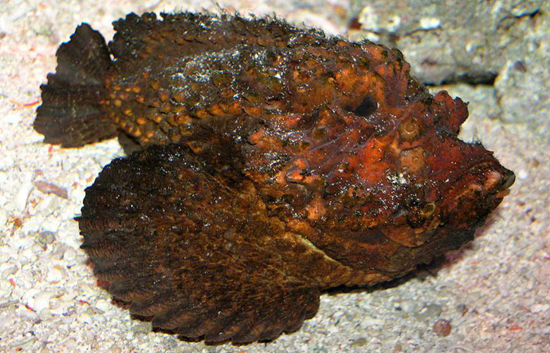
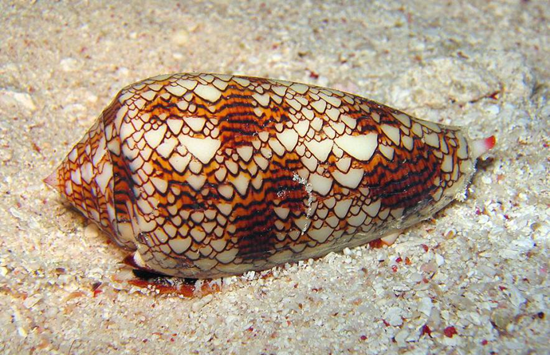
No comments:
Post a Comment
Please adhere to proper blog etiquette when posting your comments. This blog owner will exercise his absolution discretion in allowing or rejecting any comments that are deemed seditious, defamatory, libelous, racist, vulgar, insulting, and other remarks that exhibit similar characteristics. If you insist on using anonymous comments, please write your name or other IDs at the end of your message.